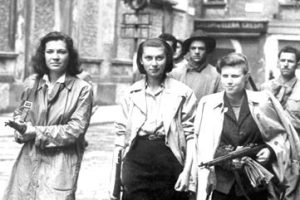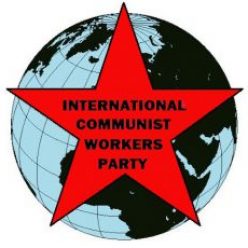
Communist partisans, Italy, during World War II
Only Communism Can Finally Defeat Fascism Everywhere
October 21—Almost exactly 100 years after Mussolini’s March on Rome brought his Fascists to power in 1922, Giorgia Meloni became Italy’s new prime minister.
Meloni is Mussolini’s direct political descendant. She and other “Brothers of Italy” leaders came from the National Alliance (AN). The AN succeeded the Italian Social Movement, formed in 1945 by members of two banned Fascist parties.
There were many repressive governments and authoritarian movements before Mussolini. But we can learn much from Fascism’s particular history. Most importantly, Fascism arose in direct contradiction to communist internationalism.
The Italian Socialist Party was the only one in western Europe to oppose the first imperialist world war. It expelled Mussolini, a former leader, in 1914 for advocating Italian military intervention.
Mussolini fought in the Italian army. Afterward, the British MI5 paid him £100 per week to publish pro-war propaganda. Imperialists wanted to discourage the massive anti-war protests that had rocked Italy since 1914. Mussolini started a newspaper, Il Popolo d’Italia, in 1917.
The Italian government had discovered that many rural and urban workers and artisans “lacked the sense of belonging to the homeland.” Anti-war forces defied repression by writing on walls and organizing demonstrations. They leafletted, petitioned, and went on strike for “bread, land, work, and peace.” They fought in street battles and local insurrections. These peaked in the summer of 1917 after the overthrow of the Russian tsar.
Russian Revolution Sparks Class Struggle Worldwide
In August 1917, a protest erupted in Turin (Italy’s industrial center) against food rationing. It spiraled into a general strike and then an insurrection. Armed workers defended barricades, fighting to seize power from the capitalists.
But, unlike Russia six months earlier, the troops sent against them had not been organized by communists to side with the revolutionary workers. Instead the rebellion was drowned in blood.
Il Popolo d’Italia denounced socialism, egalitarianism, and class struggle. Mussolini patched together a new “Fascist” ideology based on militant and expansionist nationalism, opposing working-class internationalism. It promoted class collaboration (the “corporate state”) in place of class struggle. Trust in a “strong man” instead of the masses.
Two years later he organized the paramilitary Italian Fasces of Combat.
The war’s end in 1919 brought a wave of unemployment and economic hardship. That provoked the Biennio Rosso (“Two Red Years”) of intense class struggle.
Industrial workers in Turin and Milan, led by socialists and anarchists, formed factory councils similar to Russia’s soviets. Over a million workers went on strike in 1919. A two-day general strike expressed solidarity with the Russian revolution. Now some soldiers refused to attack the working class.
But without strong Bolshevik leadership, this movement didn’t fight for power. Instead it featured factory occupations and demands for official recognition of the factory councils.
When the Communist Party of Italy split from the Socialist Party in 1921, the opportunity for communist revolution had been squandered.
Still, King Victor Emmanuel III feared revolution. So did the industrial capitalists and rural landowners behind him.
Mussolini had reorganized his forces as the National Fascist Party. The rulers chose to use these “Black Shirts” to violently suppress the mass movement. They took advantage of Mussolini’s 30,000-strong “March on Rome” on October 27-28, 1922, to appoint him Prime Minister and let him form a Fascist government.
Repression intensified and Mussolini implemented the imperialist ambitions of Italian capitalism, seizing control of Libya, Albania, and later Ethiopia.
Fascism celebrates the worst of capitalism’s ugly nature.
Capitalists embrace fascism when it suits their needs. We see this today in Meloni’s electoral coalition with Berlusconi’s Forza Italia. In US President Biden’s criticism of the Proud Boys but not of Ukrainian military units that just as openly flaunt fascist insignia.
Fascism comes to power through the capitalist state’s political structures. Some capitalist politicians embrace Fascism. Others beg us to “defend democracy.” But capitalism’s roots in wage slavery bear its fruits of nationalism, racism and xenophobia, sexism, repression of workers’ struggles, and war for profit.
“Fascist” isn’t just an insult or an epithet. But it’s not mainly a revolting ideology either. It’s capitalist dictatorship revealing its essential nature: the divisive and violent suppression of the working class.
The real fight against fascism is the revolutionary class struggle for communism.
Faced with the rise of Fascism, the Communist International decided in 1935 that the main contradiction was between fascism and democracy. They abandoned revolution against capitalism for unity with supposedly “lesser-evil” imperialists. Those included the British, who had covertly launched Mussolini!
They were wrong. The main contradiction was then – and is now – between fascism and communism. Between the open dictatorship of Capital over the masses and the open dictatorship of the communist-led masses over Capital.
Communist partisans executed Mussolini in 1945. But it remains to us to fight for and build the communist world we need.

Communist partisans, Italy, during World War II

